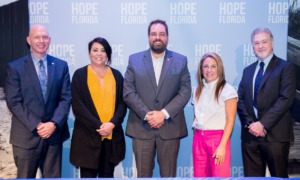For the teens in Plugged In Enterprises, the experience is part real-world business, part structured learning and part community service.
It is such a successful recipe that President Clinton visited Plugged In headquarters last month as part of a multi-city tour about closing the “digital divide.” Among the initiatives he touted was “asking Congress for $100 million for community technology centers like Plugged In.”
Plugged In started in East Palo Alto, Calif., in 1992 as an after-school program within the Boys & Girls Clubs of America, but went out on its own a couple of years later when it outgrew that location.
In 1995, it received a Department of Commerce Technology Opportunities Program (TOP) grant to create a website that put 19 East Palo Alto community centers onto the Internet, and hired local teenagers to run the site. From that grew an entrepreneurial web-page design business that creates websites for community members and paying commercial clients.
In one year, 36 teens go through the basic training course, which leads to an unpaid internship on the website production team, says Plugged In Director Magda Escobar. From there they graduate to a full-time spot on the team, and get paid.
That provides jobs and marketable skills for the teens in a low-income area that’s short of well-paid jobs despite sitting in Silicon Valley. At the same time, the youths serve as evangelists of technology to the community: For Plugged In clients, the website creation service is an introduction to computer basics and the Internet.
Plugged In also runs a project-based program for younger kids called Plugged In Greenhouses. The youths learn how to use technology through eight-week learning “modules” built around themes such as people and places, or the history of local communities.
‘We’re trying to shift kids away from using computers simply as video game consoles,” Escobar says.
One of the biggest challenges Escobar faces results from the very success of Plugged In. Three years ago the main problem was getting funds, she says. But today Plugged In’s funders include The Charles Helen Schwab Foundation, The David and Lucile Packard Foundation, The Peninsula Community Foundation, and major technology companies such as Intel, Sun Microsystems, Cisco Systems, Apple Computer and Hewlett-Packard Co.
Now the problem is getting and keeping qualified staff, something made more difficult by the training Plugged In provides. “Our last system administrator started with us as a 15-year-old, and recently went to join a technology startup at 19,” Escobar says. “And he stayed a relatively long time. People generally stick around for just a couple of years.
“The truth is that the incentives in corporate America for the kind of skills we provide are just too great.”
Plugged In is thinking about how to grow by hooking up with other partners or franchising itself. It is in talks with other cities about setting up Plugged In centers, Escobar says.






























